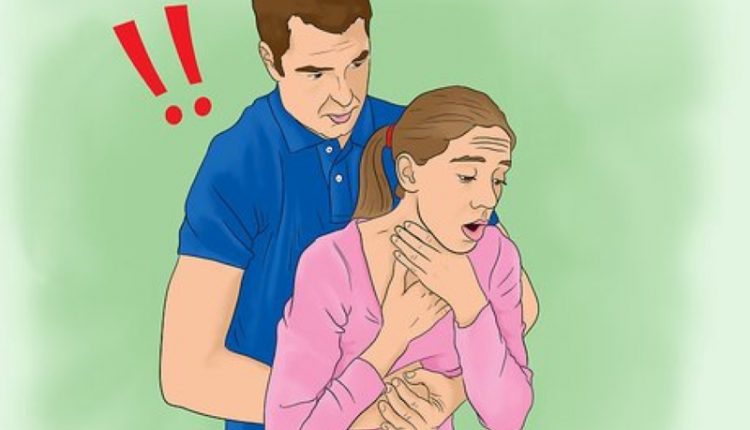
Choking: how to perform the Heimlich manoeuvre in children and adults
The Heimlich manoeuvre is a first aid technique used to quickly and easily remove an airway obstruction that, in some cases, could lead to even fatal suffocation
It is carried out using hands and arms that exert a series of rapid, deep pressures on the victim’s abdominal area below the sternum and above the navel, directing the thrust upwards so as to compress the diaphragm, thus causing a compression of the lungs that exerts a pneumatic thrust on the object obstructing the airway, to cause it to be expelled through the mouth, similar to a violent cough.
First of all, it is necessary to recognise the signs and symptoms of choking
Generally, the victim
- desperately puts his hands to his throat
- is unable to speak
- rapidly becomes cyanotic (has bluish skin and mucous membranes);
- has visibly difficult breathing;
- has breathing that often produces a high-pitched noise;
- has a persistent cough;
- has a very weak cough as he cannot fill his lungs to cough energetically;
- has miosis (pupil constriction)
- loses consciousness.
Heimlich manoeuvre on a standing or sitting person
The person practising the Heimlich manoeuvre stands behind the casualty, talking to him and explaining that he is about to perform an emergency manoeuvre, but at the same time acting decisively.
He wraps his arms around his hips, under his arms.
One hand is folded with a clenched fist and is placed with the thumb flat against the abdomen in the area between the sternum and the navel.
The other hand grasps the fist and causes a series of rapid, deep upward thrusts until the object obstructing the airway is expelled.
The thrusts should never compress or squeeze the rib cage, only the soft part of the abdomen.
The new European Resuscitation Council guidelines stipulate that 5 subdiaphragmatic compressions and 5 dorsal thrusts between the shoulder blades should be alternated.
THE RADIO OF RESCUERS AROUND THE WORLD? IT’S RADIOEMS: VISIT ITS BOOTH AT EMERGENCY EXPO
Heimlich manoeuvre on oneself
The Heimlich manoeuvre can also be practised on oneself, using the same technique: one hand is clenched into a fist and placed against one’s abdomen while the other grasps it and pushes it upwards in a series of thrusts until the airway is cleared.
Another effective self-rescue technique is to lean your upper abdomen against a fixed object (e.g. the back of a sofa or chair) and repeatedly push down with your body until the compressions facilitate the expulsion of the obstruction.
Heimlich manoeuvre on an unconscious person
If the patient is unconscious, in addition to immediately alerting help, place the patient supine (lying on their back) on a hard surface (floor or table).
Extend the head and check the oral cavity: if the foreign body is not visible and cannot be removed, two mouth-to-mouth insufflations should be performed.
If the air passage is still obstructed, proceed with external chest compressions (CTE).
After 30 compressions, the oral cavity is rechecked; if the situation is still unchanged, this is repeated (2 insufflations, 30 compressions) until breathing is restored or help arrives.
On an infant
If the infant is conscious, 5 interscapular strokes alternating with 5 chest compressions are applied to the same point where external cardiac massage is performed (just below the intermammillary line).
The Heimlich manoeuvre as such is not performed on an infant.
When the infant becomes unconscious, he is placed supine on a rigid surface, and in addition to immediately relieving the infant by calling 112, the rescuer aligns the head, uncovers the chest, and performs 5 rescue ventilations, each time aligning the head in a neutral position.
Once the 5 ventilations have been carried out, if no other assessments occur, he begins cardiopulmonary resuscitation and continues with the resuscitation protocol for the first minute, then telephoning and updating the emergency services.
It then absolutely continues until the victim is unconscious, or until advanced help arrives, or until the rescuer is physically exhausted.
Suffocation after clearing the airway
After clearing the airway, by expelling the object or liquids that obstructed it, it is still possible, especially if the victim has lost consciousness, that breathing does not resume spontaneously.
Continuing the Heimlich manoeuvre does not cause breathing to resume.
In this case, since cardiocirculatory arrest is possible, artificial respiration or cardiopulmonary resuscitation should be used as needed.
Medical support is always useful and necessary after the Heimlich manoeuvre:
- if the person is able to breathe again: a medical check-up is appropriate to rule out possible secondary trauma or residual minor obstructions;
- if the person is not breathing: an emergency call is essential, which the rescuer will make – if he is alone with the casualty – not before the end of the first cycle of insufflations and compressions.
Read Also
Emergency Live Even More…Live: Download The New Free App Of Your Newspaper For IOS And Android
Asphyxia: Symptoms, Treatment And How Soon You Die
Emergency Interventions: The 4 Stages Preceding Death By Drowning
Drowning Resuscitation For Surfers
Cardiac Holter, Who Needs It And When
ERC 2018 – Nefeli Saves Lives In Greece
First Aid In Drowning Children, New Intervention Modality Suggestion
Water Rescue Dogs: How Are They Trained?
Drowning Prevention And Water Rescue: The Rip Current
Water Rescue: Drowning First Aid, Diving Injuries
RLSS UK Deploys Innovative Technologies And The Use Of Drones To Support Water Rescues / VIDEO
Summer And High Temperatures: Dehydration In Paramedics And First Responders
First Aid: Initial And Hospital Treatment Of Drowning Victims
First Aid For Dehydration: Knowing How To Respond To A Situation Not Necessarily Related To The Heat
Children At Risk Of Heat-Related Illnesses In Hot Weather: Here’s What To Do
Summer Heat And Thrombosis: Risks And Prevention
Dry And Secondary Drowning: Meaning, Symptoms And Prevention
Drowning In Salt Water Or Swimming Pool: Treatment And First Aid
Water Rescue: Drone Saves 14-Year-Old Boy From Drowning In Valencia, Spain



